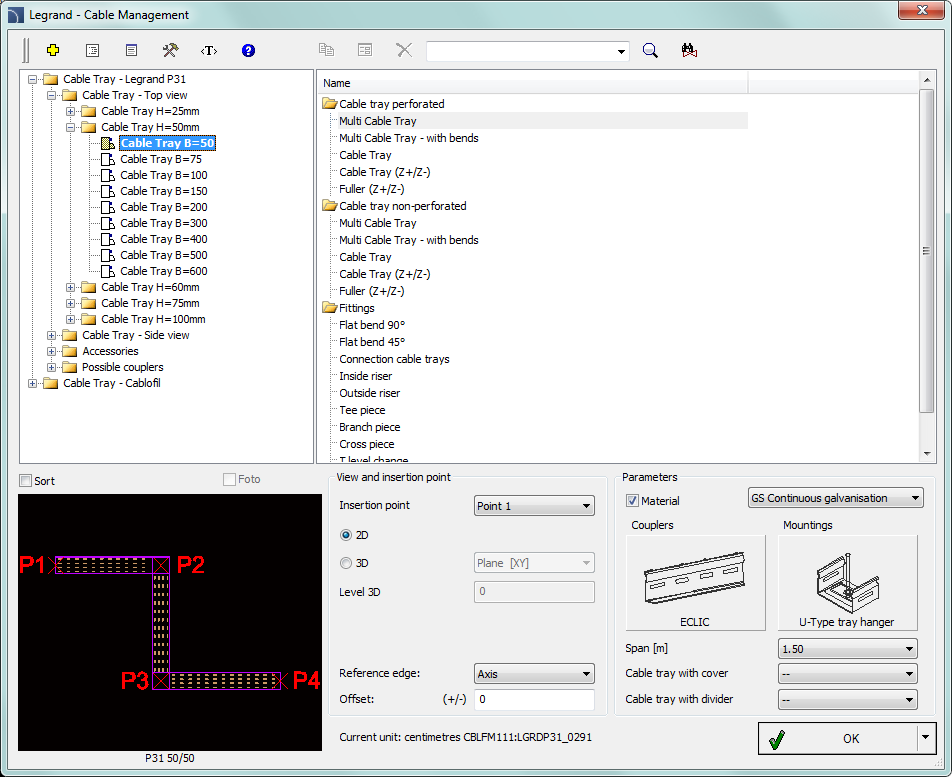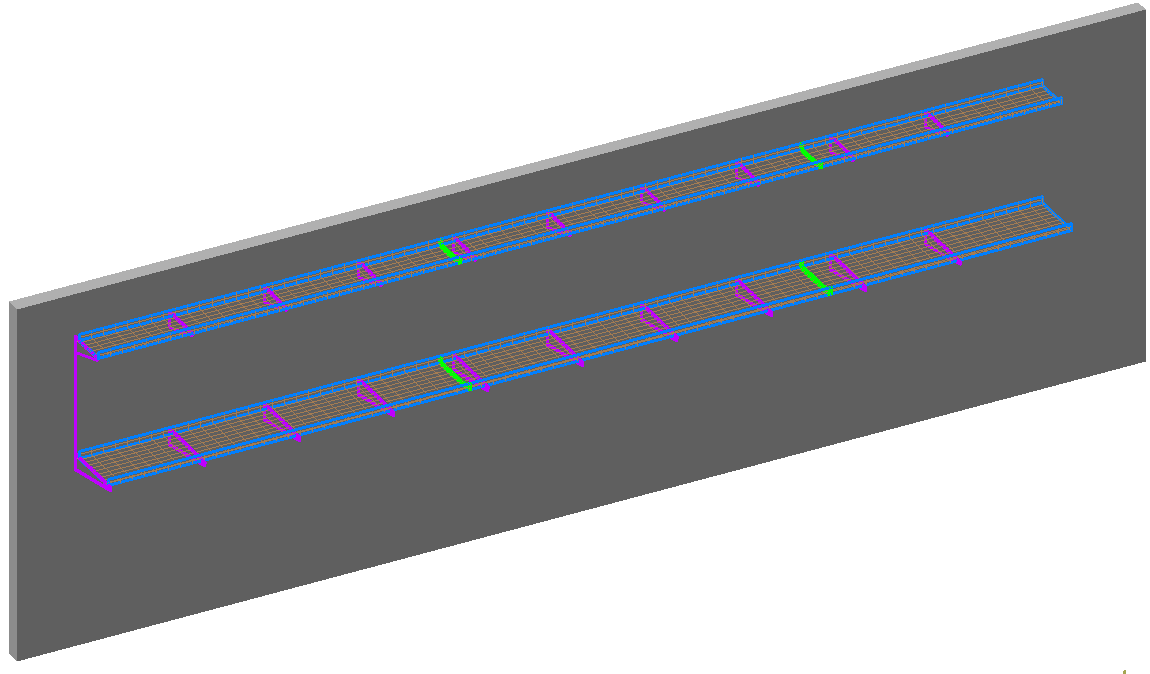 or the Join general
elements
or the Join general
elements  command is used.
command is used.In CADprofi program it is possible to draw Cablofil mesh trays.
This system is available in the Manufacturers library) command.
This command allows to draw single
trays or automatic drawing of tray sequences with simultaneously insertion of
elbows (or without elbows). Tees and reducers are also available.
These
objects are automatically connected to trays (one–click technology).
For more convenient edition of trays with automatic insertion
of elbows and tees the Cablofil –
Couple cable trays  or the Join general
elements
or the Join general
elements  command is used.
command is used.

|
|
During the drawing of strings, program automatically inserts elbows and trays in accordance with points indicated by the user. By setting the reference edge and offset it’s possible to draw strings for example along the walls. |
|
In Legrand CabloCAD
you can select couplers and the type and spacing of tray mounting pieces.
The data is used to calculate the quantity of accessories necessary for
the installation of the designed systems. |
|
Legrand CabloCAD application allows to draw cable
trays in 3D model.
For the 3D mode it is possible to:
|
•Draw strings in the XY plane of any level, which can be specified in the dialog window (Level 3D edit box). •Use the command for automatic connection, which requires that both joined elements must be on the same XY plane (their level must be the same). •Attach elements with the one-click method. It is possible in every case, regardless of the position of the object. |
|
Schematy mocowań – this category contains diagrams representing the tray mounting method. Mounting piece diagrams are used only as graphical supplementary information. Therefore, mounting piece symbols are not used in the creation of bills of materials.
|
For automatic insertion of diagrams of mounting pieces, you can use the Insert: 2D/3D, Symbols, Descriptions….
|
|
Akcesoria – this
category contains additional components, i.e. handles, fire retardant baffles,
etc. Components inserted in the design will be taken into account when creating
bills of materials.
Some components, such as clamps, handles, etc., are too
small to show in views. In Legrand CabloCAD, instead of inserting a defined
quantity of ‘minor’ objects into the design, you can insert a table of
additional components. Components with a specified quantity will be taken into
account in the bills of materials..
To edit additional components, you can
use AutoCAD/IntelliCAD commands for editing attributes or the Attributes and descriptions command.

Connecting pieces catalogue – In designs created with Legrand CabloCAD, data about connecting pieces is taken into account when drawing trays. Therefore, it is not necessary to insert connecting pieces into the design as graphical objects. In the connecting pieces catalogue, you can only view technical information about Legrand CabloCAD connecting pieces.
Trays material - During
designing it is possible to specify the Cablofil
mesh trays material. Program inserts trays that are created with different
materials on separate layers.
For example the 2DE_OBP_CblfEZ layer is used for Cablofil electrolytically galvanized (EZ), the 2DE_OBP_Cblf316L
layer is used for trays made of stainless steel (316L).
During insertion of Cablofil elements program checks the layer name and includes only elements that lie on layers that begin with the 2DE_OBP_Cblf. Because of that user should not change the trays layer name.

An exception of this rule may be for example a necessity to add
additional red layer for anti fire or other special installations. For example
the 2DE_OBP_CblfEZ_ppoz can be used in anti fire
installations for electrolytically galvanized trays. In such case in Cablofil BOMs instead of material, the layer name will be
visible.
|
To change the material and
other trays parameters user can sue the Cablofil – Match properties To avoid misallocation of tray material it is not recommended to change the trays layer with the CAD program standard options. |
|
Complex constructions
In real installations it is very often needed to conduct trays one above the other. Sometimes such constructions can consist of many trays that are mounted to the ceiling, walls, etc. On plans it is very difficult to represent such constructions, because many trays that overlap each other, therefore the project becomes unreadable.
This problem is solved by "complex constructions". In this case instead of drawing many trays that overlap, it is possible to draw a route, which shows the trays sequence and a scheme that represents the arrangement of ducts and fittings in the route.

Example: two trays – one above the other
 |
2D drawing – advanced construction in CabloCAD
Complex construction scheme must contain:
1. Construction marking symbol – marking must be unique (e.g. C01, A15 etc.). In one project it is not possible to define several complex constructions with the same marking (ID).
2.
Mounting – scheme that contains special mounting
symbols. When inserting mounting symbols the mounting spacing and construction
ID must be provided
(e.g. C01, A15…).
3. Trays cross-section – when inserting mounting symbols user should also specify the couplers type, thanks to which trays and construction markings are connected (e.g. C01, A15…).
Trays route – when drawing a tray route it is necessary to specify its total width and height that is occupied by all trays in the specified route.
Notice:
To a specified complex construction (e.g. C01) belong all elements that contain the specified ID (e.g. C01). For this reason, for visual control, the ID is visible in all mounting symbols and trays cross-section. This ID is on a non-printed layer, that's why it is visible only on the screen.
In a definition of one complex construction (i.e. one design) it should be avoided to mix elements with different IDs. When copying elements between constructions it is necessary to arrange IDs (i.e. construction attribute marking).
|
It is not possible to define several same complex constructions in a project. For this reason schemes with complex construction definition should not be duplicated. This can lead to errors when creating BOMs (duplicated elements in the drawing can duplicate the number of trays and accessories in BOMs). If user needs to duplicate schemes of complex constructions, all copies should be "exploded" or they must have "cleared IDS" (empty marking attribute). These copies won't be included by the program in BOMs). |
